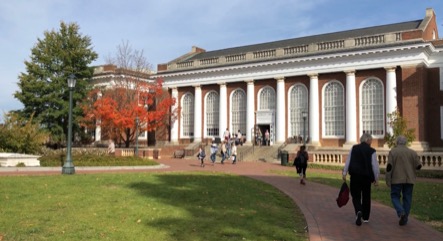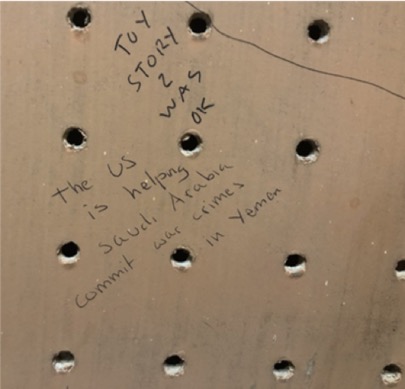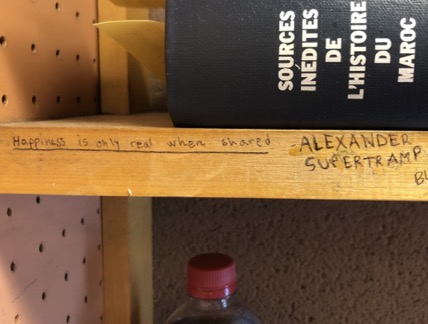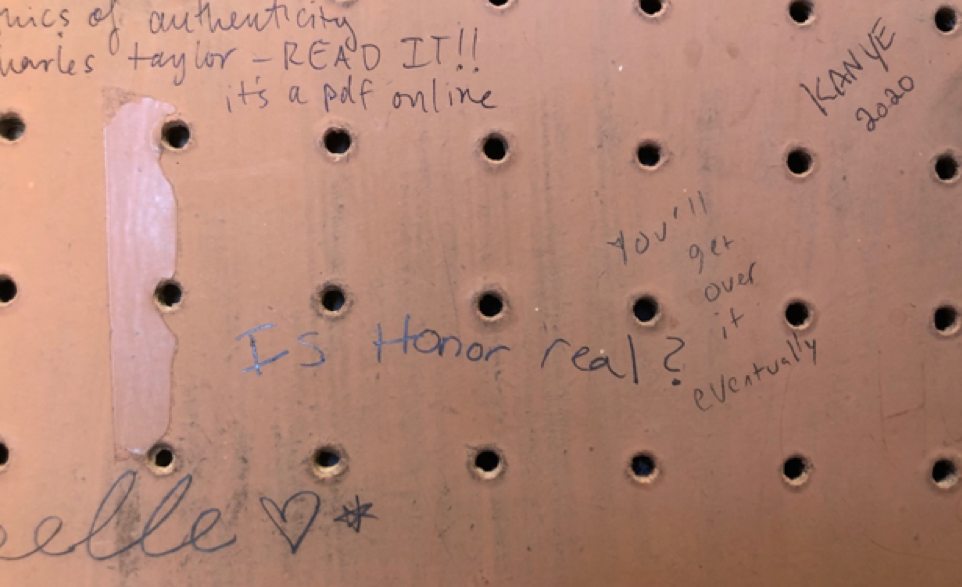Guest post by: Kennedy Castillo (UVA Linguistics MA, 2019), Lise Dobrin (UVA Associate Professor of Anthropology and Linguistics Program Director), Liam Donohue (UVA Anthropology and Environmental Science BA, 2019), Grace East (UVA Anthropology PhD Candidate), Edith Kachia (Visiting Fulbright Swahili TA, 2018-19), Jenny Lee (UVA English and American Studies BA, 2019), Dakota Marsh (UVA English BA, 2020), Jacob Nelson (UVA Linguistics BA, 2020), Will Norton (UVA Linguistics BA, 2020)
Ahead of a comprehensive renovation of Alderman Library that will affect most of the building, the students in the spring 2019 seminar course Literacy and Orality, taught by UVA Anthropology professor and documentary linguist Lise Dobrin, took it upon themselves to preserve an overlooked piece of UVA’s cultural record before it disappears: the scribbles, scratches, text, and art that for years have graced and defaced the library’s hidden study carrels. From April to June, we photographed as many carrels as we could, compiled the results into a database, and sifted through countless forms of graffiti to get a sense of decades of UVA students’ hopes, fears, pet peeves, and unsolicited opinions. The graffiti reveals conversations playing out in slow motion between otherwise isolated crammers. It voices the anxieties and aspirations of contemporary college students striving to leave their mark on a large and sometimes impersonal institution.

Defacing the Temple
Universities originated as religious institutions dedicated to training the clergy of Medieval Europe. For most of their early history, they were designed with chapels as their centerpieces, reminding students that all their activities were to be in service to the Church.
But at the University of Virginia, Thomas Jefferson sought to advance his vision of a secular republic by placing a library, not a chapel, at the center. That library was the building we now know as the Rotunda. Though the University has since outgrown its original library, it has never lost the reverence for the book that shaped its original design. In a sense, a University library is a kind of temple that enshrines the book as the most prestigious form of writing and knowledge. Yet for generations the University’s students have enthusiastically scrawled on the library’s surfaces in pen, pencil, and marker in a devalued form of writing: graffiti. The result of this rebellious impulse is a platform through which “high” and “low” texts commingle and University culture is explored privately in a public space. How can it be that graffiti flourishes in the same physical location where the most rarified texts are enshrined?

The Alderman New Stacks Graffiti Collection
There are 176 carrels in the Alderman New Stacks. We have photographed 79 of these so far. The photographs are stored in a database, organized by carrel, and then catalogued with annotations and transcriptions according to the various themes found in the multiple instances of graffiti documented in each photograph. The number of photos we have for each carrel ranges from 10 to 95, with the average about 40 per carrel. In total, we have collected over 3,500 photographs of graffiti and completed description and annotation of 28 carrels.
Beyond the unsurprising presence of indecent doodles in many carrels, the graffiti we have collected and analyzed ranges widely in topic, addressing anything from Greek and academic life at UVA to politics, poetry, film, and music. Phrases in Spanish, French, and even Tibetan have been recorded.

In order to properly catalog the graffiti, we researched phrases or names that were unknown to us, such as the unattributed quote in Carrel 4-14 and the personal name depicted in Carrel 4-15, so that we could use what we learned to annotate the corresponding images in the database.


With the Library’s support, we continued to document and annotate the graffiti through the summer of 2019, after which time the organized and annotated images are being donated to Special Collections to be preserved for posterity. Through our careful documentation, future students will be able to catch a glimpse of what their forebears had in mind and recorded in their surroundings as they studied in the storied stacks of Alderman Library before the renovation.
Why Do Students Write Graffiti?
We had known since the start of this project that we were unlikely to find the graffiti’s authors and that this would limit our ability to contextualize their messages. Internet memes, song lyrics, and other pop culture references might be validated by an internet search, but that still leaves a large majority of graffiti unattributed. But eventually we understood that the very anonymity we found so frustrating was one of the motivations for students to write the graffiti in the first place.
Unless they get caught red-handed or decide to sign their work, graffiti authors can be confident that their ideas will not be traced back to them. This makes graffiti an ideal vehicle for sharing unseemly gossip or ideas that might not be sanctioned by the university or their peers.

Typically viewed as a form of vandalism, graffiti is often found hidden away rather than in open public spaces. The graffiti we focused on is etched onto carrel after carrel of the Alderman New Stacks, which are located as deep inside the building as one can get from the main entrance. Sequestered in the maze-like, claustrophobic stacks, the study carrels surround students with barriers to discourage discussion and aid concentration. Theoretically each carrel is assigned to a specific graduate student, but unless the assigned student is present, anyone who wishes may use the carrel. The New Stacks are known for being a place where one goes to be immersed in silence and where any loud move will draw death stares from everyone around. In this atmosphere of isolation and silence, students feel free to express themselves.

On the carrel walls UVA students unburden themselves of secrets and taboo thoughts that they would not feel comfortable expressing in an open public space.

In this respect, the Alderman carrels are not unlike an anonymous internet forum, something we find especially intriguing given that one of the best known such forums, reddit.com, was founded at Alderman Library.


Sometimes the anonymity of carrel graffiti is subverted through direct name references. It is much less risky to insult people by name when the writer remains anonymous.

The Graffiti’s Conversational Form
The wood lining of Carrel 4-9 illustrates the way graffiti can unfold in a slow conversation over time. An initial provocation elicited responses from two different readers, the latter responder disagreeing with the first.

At times the carrel walls act as a public opinion forum where students conduct conversation about events of major significance at UVA. The image below, for instance, illustrates differing perspectives on the now infamous case of alleged sexual assault at UVA’s Phi Kappa Psi fraternity that was described in a 2014 Rolling Stone magazine article and subsequently retracted. The comment in the middle of the image expresses a view sympathetic to the members of the implicated fraternity by calling the case a “witch hunt.” This original comment is in turn surrounded by responses. One below the original statement expresses agreement, while another above dismisses it as a baseless complaint typical of entitled “whiny rich boys,” which itself is responded to with a crossing out. Two other writers engage in a grammatical debate, quibbling over whether the men of Phi Psi are being “persecuted” or “prosecuted.” This example illustrates how multiple students using the same carrel use graffiti to offer commentary both on campus issues and on the discourse surrounding those issues.

In carrel 4-15 the conversation taking place over time was even more complex. Here the graffiti authors even used arrows to help specify what exactly they were responding to. Along with the arrows, crossing out a piece of the initial message and writing something above it was used to show disagreement. A “+1” was written next to the first additional comment to indicate agreement. While the precise chronology of the comments cannot be determined with certainty, the arrows and other information help differentiate between conversational turns.

Greek Life
Fraternities and sororities are a big part of student life at UVA, so the sequences of Greek letters that identify each such organization are ubiquitous elements of carrel graffiti. The edges of carrel bookshelves are particularly popular places to inscribe Greek-society insignia. Many of these inscriptions are scratched out or commented on, enacting on-going rivalries between Greek organizations. While the differences between these societies may be important from within the Greek system, to an outsider they can seem largely interchangeable. Just like the Greek-letter format itself, the pen or marker scrawlings on a study carrel allow members to declare allegiance to a specific group, but in a highly standardized way.

Fraternities and sororities are deeply gendered institutions, and this is evident in much of the carrel graffiti. Sorority letters frequently draw responses cast in overtly sexist language.

Students uninvolved in the Greek system may treat it with fascination and disdain. Some have even created their own pseudo-Greek insignia, GΔI, said to stand for “God Damn Independent” (replacing the D with the Greek letter Delta).

Students play with the Greek-letter formula in other creative ways, incorporating it into unrelated words and jokes.

The Carrel as an Exhibit Space

Although in a sense each carrel is an exhibit space giving viewers something to behold and consider, carrel 4-9 stands out. While its walls, shelves, and desks are covered in graffiti much like the other study spaces, carrel 4-9 includes something that none of the other carrels do: origami figures made from study and lecture notes. Where did these figures come from? What inspired their creator(s) to make them? The only text accompanying the origami are a couple of hand-written sticky notes thanking the origami artist(s) for their creations. We learned from talking with library faculty that the origami had been there for at least two years. How many individuals have contributed to the collection? We will never know. Just like the graffiti, these figures were created anonymously.
Support from the Top
From the very beginning of this project, UVA’s Dean of Libraries John Unsworth took a keen interest in our documentation process, our motives, and our plans for displaying our findings. In May, three members of our group met with Dean Unsworth to find out what made the project meaningful to him.

Although he was first interested in graffiti as a form of artistic expression, Unsworth told us, he began thinking more deeply about its documentary function after a former student of his published a book displaying the different subgenres of graffiti that she found in the University of Chicago’s Regenstein Library.[1] Since then, he has invested in other projects focused on graffiti, most notably the Pompeii Forum Project, directed by UVA Art History professor John Dobbins. Unsworth draws parallels between the graffiti that was found at Pompeii and the graffiti found within the carrels of Alderman Library insofar as both are endangered texts. Much of Pompeii’s graffiti was lost forever when Pompeii was destroyed by a volcanic eruption, just as the Alderman graffiti will be lost in the renovation.
Even after the renovation, Dean Unsworth has no plans to prevent students from writing graffiti in the stacks. “I’d rather have people writing on the walls than in the books,” he explained. When discussing what Alderman would be like after the renovation, Unsworth mentioned that the recreation of different kinds of study spaces within the library would be a priority. His plans include using artwork to create a wide array of atmospheres for students to study in. He even hinted at the possibility of commissioning professional graffiti artists to adorn some of Alderman’s wall space. The existing graffiti in Alderman will be lost in the coming semesters, but graffiti has been around long before Pompeii and will be around long after Alderman has been renovated.
Preserving the Past for the Future
Alderman Library was named after Edwin Alderman, who served as the first President of the University from 1904-1931. His goals were to transform the Southern university into a powerhouse for state service and intellectual curiosity, ultimately modernizing Virginia’s higher education system. During his time at the University, Alderman forged long-lasting, impactful, and meaningful strides in service, such as helping create the Curry School of Education and contributing significantly to the University Hospital. However, as with many other early major leaders at the University, President Alderman contributed to a complicated history that conflicts with the founder’s creed that “all Men are created equal.” In 1924 Alderman welcomed the statue of Robert E. Lee that nearly a century later would serve as the flashpoint for a national crisis that resulted in multiple injuries, personal traumas, and one untimely death. Reading through the Alderman graffiti contextualizes the cultural events taking place in and around the University at this time in its history. Our project documents all forms of graffiti, from contemplative musings and inspirational quotes to vitriolic and unsettling slogans. The students who wrote the graffiti were University of Virginia students and each of them contributed to its culture. We hope that surveying the array of art, scribbles, and other inscriptions we have documented will help those in the future understand more about what student life was like at UVA before the renovation. We hope it will inspire a new generation of Alderman users to think critically about our past and our future both inside and outside Jefferson’s temple of learning.

Check out the graffiti gallery for more, and head over to Alderman Library. The class has put together a mini-graffiti hunt on the 4th floor—look for the “Alderman Graffiti Hunt” bookmarks at the circulation desk in Memorial Hall.
[1] Dombrowski, Quinn. Crescat Graffiti, Vita Excolatur: Confessions of the University of Chicago. Chicago: Q. Dombrowski, 2009.
